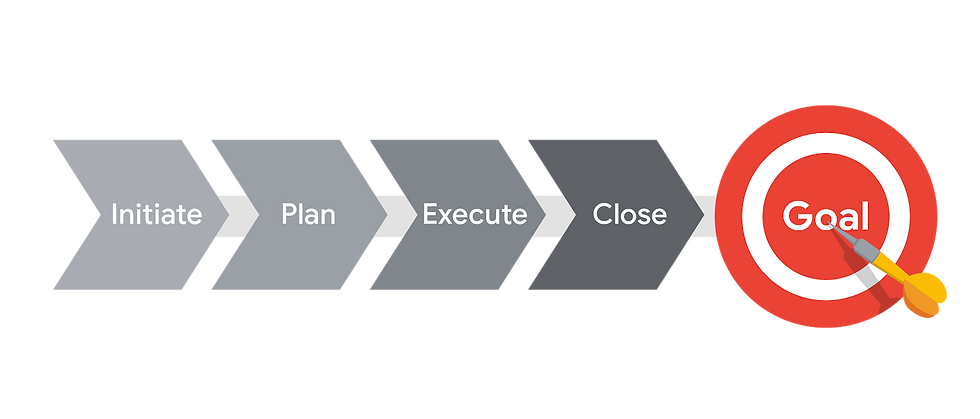Summary of the project phases
- Svetlana Gubaydullina
- Jan 20, 2022
- 3 min read
The project life cycle is the path for your project from start to finish. Each project phase builds toward the subsequent phase and helps to create a structure for the project. To recap, the main phases of the project life cycle are: initiating the project, making a plan, executing and completing tasks, and closing the project. In this reading, we will summarize each phase of the project life cycle.

The project life cycle
Initiate the project
In this phase, ask questions to help set the foundation for the project, such as:
Who are the stakeholders?
What are the client’s or customer’s goals?
What is the purpose and mission of the project?
What are the measurable objectives for the team?
What is the project trying to improve?
When does this project need to be completed?
What skills and resources will the project require?
What will the project cost? What are the benefits?
Make a plan
In this phase, make a plan to get your project from start to finish.
Create a detailed project plan. What are the major milestones? What tasks or deliverables make up each milestone?
Build out the schedule so you can properly manage the resources, budget, materials, and timeline. Here, you will create an itemized budget.
Execute the project
In this phase, put all of your hard work from the first two phases into action.
Monitor your project team as they complete project tasks.
Break down any barriers that would slow or stop the team from completing tasks.
Help keep the team aware of schedule and deliverable expectations.
Address weaknesses in your process or examine places where your team may need additional training to meet the project’s goals.
Adapt to changes in the project as they arise.
Close the project
In this phase, close out the project.
Identify that your team has completed all of the requested outcomes.
Release your team so they can support other projects within the company.
Take time with your team to celebrate your successes!
Pass off all remaining deliverables and get stakeholder approval.
Document the lessons you and your team learned during the project.
Reflect on ways to improve in the future.
Key takeaway
Each phase of the project life cycle has its own significance and reason for existing. By following the project life cycle, you’re ensuring that you are:
Capturing the expectations of your customer
Setting your project up for success with a plan
Executing project tasks and addressing any issues that arise
Closing out your project to capture any lessons learned.
As you continue through this course, we will walk through each project phase in more detail.
Test your knowledge: Analyzing the different project phases Total points 4
1.
Question 1
What is the project manager’s primary job in phase three (execute and complete tasks) of the project life cycle?
1 / 1 point
Step in to complete tasks when the team falls behind
Build out the project schedule to properly manage resources, budget, and timeline
Document lessons the team learned during the project
Monitor the project team as they complete tasks and break down any barriers
Correct
The project manager’s primary job is to oversee the team's efforts and make sure everyone understands what's expected of them, what tasks need to be done, and how and when to complete those tasks.
2.
Question 2
Phase two of the project life cycle (make a plan) includes which two of the following tasks?
1 / 1 point
Break down any barriers that would slow or stop the team from completing tasks
Determine the purpose and mission of the project
Set the project schedule
Correct
In the planning phase, the project manager develops the project schedule so they can properly manage the resources, budget, materials, and timeline.
Identify milestones and tasks
Correct
In the planning phase, the project manager creates a detailed project plan which includes the major milestones of the project and describes what tasks or deliverables make up each milestone.
3.
Question 3
During which phase of the project life cycle does a project manager hand off all remaining deliverables?
1 / 1 point
Execute and complete tasks
Close the project
Initiate the project
Make a plan
Correct
A project manager hands off deliverables and gets stakeholders to sign off during the closing phase.
4.
Question 4
Imagine a project manager oversees their company’s transition to a new financial management system. They determine that the project goal is to make the financial portal easier for employees to use. They also identify key stakeholders and outline project objectives. During which phase of the project life cycle do these activities take place?
1 / 1 point
Make a plan
Execute and complete tasks
Close the project
Initiate the project
Correct
In the initiation phase, the project manager defines the client or customer’s goal, identifies key stakeholders, and determines measurable objectives for the team.

Comments